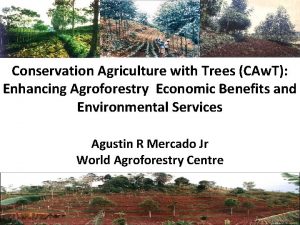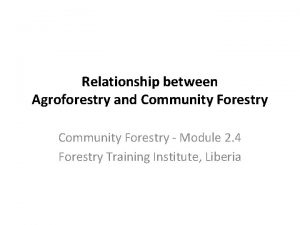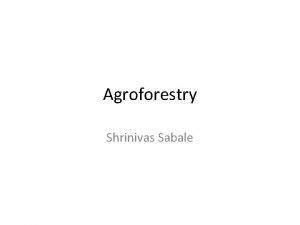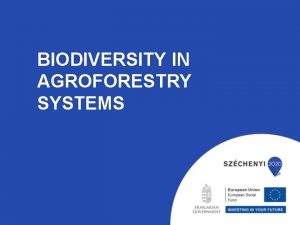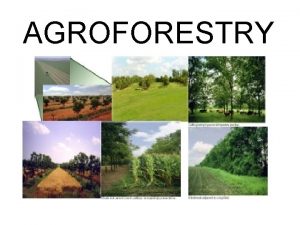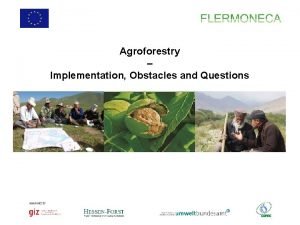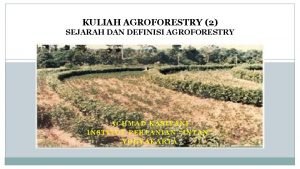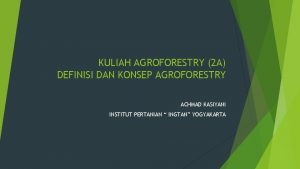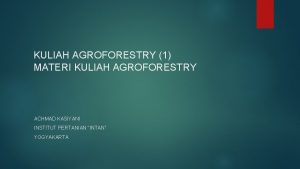An Introduction to Agroforestry What is Agroforestry Agroforestry









- Slides: 9

An Introduction to Agroforestry

What is Agroforestry? Agroforestry is when agriculture and trees are combined in the same area. It can include hedges and shrubs as well as trees, and be combined with both crops and livestock (sometimes called silvoarable or silvopasture). For example, sheep might graze on pasture amongst fruit trees, or wheat might grow in fields within rows of willow hedges. Agroforestry with livestock in Devon Agroforestry with wheat at Wakelyns Farm, Suffolk

What are the benefits and disadvantages of Agroforestry systems in farming? Disadvantages Trees and shrubs can compete with crops or grazing pasture for space, light, water and nutrients in the soil. This can lead to lower yields of crops, or less food for livestock. However, good agroforestry design and management can counter potential crop yield losses as the trees help to protect crops from our increasingly extreme weather caused by climate change e. g. improved drainage and reduced wind speeds. Large modern machinery such as combine harvesters may not be able to manoeuvre around the trees if the rows of trees and shrubs or ‘alleys’ are spaced closely together. Additional machinery may be needed to maintain and harvest the trees. Short-term tenancies offered to farmers who rent their land can also prevent investment in long-term tree crops.

What are the benefits and disadvantages of Agroforestry systems in farming? Advantages Although there may be lower main crop yields, an agroforestry system can compensate the loss by producing additional crops or products to sell or use. For example, trees can provide fruit or timber, and hedges can be cut and chipped for fuel or soil improver. Furthermore, many livestock like to eat trees’ leaves, and shelter under them from the weather. Diversifying into a wider range of crops also helps to make farm businesses more resilient to both unpredictable crop harvests and fluctuating market prices. There is also evidence that trees and hedges can benefit crops and the soil. For example, their roots can bring water up from deep underground, their leaves drop in autumn which helps soil structure and feeds microorganisms, and they shelter crops from wind and reduce soil erosion and evaporation. They can also help reduce the spread of air borne diseases such as potato blight by creating a barrier, attract pollinators for insect pollinated crops and provide habitat for beneficial insects which feed on other insects which damage crops.

What are the benefits and disadvantages of Agroforestry systems in farming? Advantages The benefits for wildlife and the environment as a whole are perhaps more obvious. Trees and hedgerows provide vital food and habitat for a wide range of insects, birds and small mammals. Trees and hedges also store carbon as they grow which helps mitigate climate change, although how much compared to crops and pasture is a complex issue. Lastly, trees are being increasingly recognised as important to our overall wellbeing; not only are they beautiful and of course create oxygen, but there is also growing evidence that trees can help to reduce stress by producing cortisol, and boost our immune system through the production of phytoncides.

Examples of Agroforestry Farms in the UK Growing crops and keeping livestock alongside trees and hedges has been practised around the world for hundreds of years, but modern farming methods with their heavy machinery have led to its widespread decline. However, due to the advantages described above, there is a growing interest in agroforestry systems. Here are some examples in the UK: Wakelyns Agroforestry Farm in Suffolk was one of the first modern agroforestry sites using arable crops to be planted in the UK. It was established in the 1990’s as a research farm, including experimenting with different kinds of trees and tree management within an agroforestry system. Whitehall Farm near Peterborough has rows of apple trees in between the arable crops. Here the trees have made a significant impact on reducing soil erosion on the windy, flat landscape of the Fens. The apples and apple juice are sold in the farm shop. G’s - Dimmocks Cote Farm in Cambridgeshire has large trees which act as windbreaks to protect their vegetable crops from wind, reduce soil erosion and reduce evaporation after rain or irrigation. Wakelyns Farm Whitehall Farm

Other types of agroforestry Forest Gardens are also a form of agroforestry. These areas of woodland which contain mainly trees, shrubs and plants which have been selected for their use as food, medicine or materials (e. g. for building or crafts). The main difference to agroforestry farms is that the majority of the crops are perennial rather than annual (they do not need to be sown every year), and are usually harvested by hand or with small-scale machinery. Rewilding is another term being used for planting more trees on farmland or ex-farmland. Areas of trees and shrubs can be planted (or left to establish by themselves) for humans’ recreational use and to benefit wildlife and the environment. However, some farmers are now incorporating rewilded areas into their farm, or even turning the whole farm into areas of lightly managed woodland meadows where livestock graze within the wilderness!

Links and Resources Further information • The Woodland Trust • The Soil Association’s Agroforestry Handbook Examples of Agroforestry in the UK • Wakelyns Organic Agroforestry Farm, Suffolk • Whitehall Organic Agroforestry Farm, Cambridgeshire Forest Gardens • Agroforestry Research Trust • The Permaculture Association Rewilding • Somerleyton Estate • Knepp Estate

